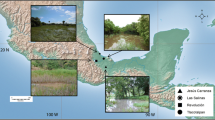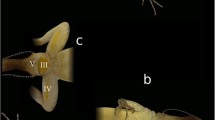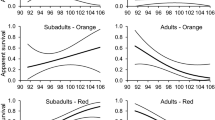Abstract
Coloration is often key in animal communication, and is frequently subjected to strong natural and sexual selection, often with opposed directions: natural selection typically favors cryptic colorations whereas sexual selection may favor conspicuous colorations. Also, different coloration traits may convey different pieces of information. Plus, coloration may vary among habitats, mirroring local selective pressures. In this work, we test if color parameters (luminosity, chroma, and hue) of back and throat are related to different life-history and morphological traits in Epidalea calamita toads. Furthermore, we check possible variability of color parameters between agrosystem and natural habitat toads. Toad coloration was sexually dimorphic, which suggests a role of coloration in sexual communication. Moreover, coloration correlated with age, body size, hindlimb length, and sprint speed. These findings suggest communication based on coloration beyond sex recognition: coloration could act as a signal of overall quality of bearers, with a potential role in mate choice. Moreover, coloration differed between habitats. Greener backs in agrosystem toads could indicate greater intensity of predator pressure, while their higher saturation could indicate greater investment in mate attraction. This result is aligned with previous findings that agrosystem toads respond to reduced lifespan with greater reproductive investment.



Similar content being viewed by others
References
Andersson, S., & Prager, M. (2006). Quantifying colors. In K. J. McGraw & G. E. Hill (Eds.), Bird coloration volume I: Mechanisms and measurements (pp. 41–89). Cambridge: Harvard University Press.
Arai, E., Hasegawa, M., Makino, T., Hagino, A., Sakai, Y., Ohtsuki, H., et al. (2017). Physiological conditions and genetic controls of phaeomelanin pigmentation in nestling barn swallows. Behavioral Ecology, 28, 706–716.
Avilés, J. M., & Parejo, D. (2013). Colour also matters for nocturnal birds: Owlet bill coloration advertises quality and influences parental feeding behaviour in little owls. Oecologia, 173, 399–408.
Banks, B., Beebee, T. J. C., & Denton, J. S. (1993). Long-term management of a natterjack toad (Bufo calamita) population in southern Britain. Amphibia-Reptilia, 14, 155–168.
Bell, R. C., & Zamudio, K. R. (2012). Sexual dichromatism in frogs: natural selection, sexual selection and unexpected diversity. Proceedings of the Royal Society B, 279, 4687–4693.
Boomsma, J. J., & Arntzen, J. W. (1985). Abundance, growth and feeding of natterjack toads (Bufo calamita) in a 4-year-old artificial habitat. Journal of Applied Ecology, 22, 395–405.
Bowcock, H., Brown, G. P., & Shine, R. (2009). Beastly bondage: The costs of amplexus in cane toads (Bufo marinus). Copeia, 2009, 29–36.
Burtt, E. H. (1981). The adaptiveness of animal colors. BioScience, 31, 723–729.
Candolin, U. (2003). The use of multiple cues in mate choice. Biological Reviews, 78, 167–176.
Caro, T. (2005). The adaptive significance of coloration in mammals. BioScience, 55, 125–136.
Cloudsley-Thompson, J. L. (1999). Multiple factors in the evolution of animal coloration. Naturwissenschaften, 86, 123–132.
Clusella-Trullas, S., van Wyk, J. H., & Spotila, J. R. (2007). Thermal melanism in ectotherms. Journal of Thermal Biology, 32, 235–245.
Comas, M., Reguera, S., Zamora-Camacho, F. J., Salvadó, H., & Moreno-Rueda, G. (2016). Comparison of the effectiveness of phalanges vs. humeri and femurs to estimate lizard age with skeletochronology. Animal Biodiversity and Conservation, 39, 237–240.
de Luna, A. G., Hödl, W., & Amézquita, A. (2010). Colour, size and movement as visual subcomponents in multimodal communication by the frog Allobates femoralis. Animal Behaviour, 79, 739–745.
Dey, C. J., Valcu, M., Kempenaers, B., & Dale, J. (2015). Carotenoid-based bill coloration functions as a social, not sexual, signal in songbirds (Aves: Passeriformes). Journal of Evolutionary Biology, 28, 250–258.
Endler, J. A. (1990). On the measurement and classification of colour in studies of animal colour patterns. Biological Journal of the Linnean Society, 41, 315–352.
Galeano, S. P., & Harms, K. E. (2016). Coloration in the polymorphic frog Oophaga pumilio associates with level of aggressiveness in intraspecific and interspecific behavioral interactions. Behavioral Ecology and Sociobiology, 70, 83–97.
Gilford, T. (1988). The evolution of conspicuous coloration. The American Naturalist, 131, S7–S21.
Giraudeau, M., Friesen, C. R., Sudykam, J., Rollings, N., Whittington, C. M., Wilson, M. R., et al. (2016). Ageing and the cost of maintaining coloration in the Australian painted dragon. Biology Letters, 12, 20160077.
Gomez, D., Richardson, C., Lengagne, T., Derex, M., Plénet, S., Joly, P., et al. (2010). Support for a role of colour vision in mate choice in the nocturnal European treefrog (Hyla arborea). Behaviour, 147, 1753–1768.
Gomez, D., Richardson, C., Lengagne, T., Plénet, S., Joly, P., Léna, J. P., et al. (2009). The role of nocturnal vision in mate choice: Females prefer conspicuous males in the European tree frog (Hyla arborea). Proceedings of the Royal Society B, 276, 2351–2358.
Gomez, D., Richardson, C., Théry, M., Lengagne, T., Léna, J. P., Plénet, S., et al. (2011). Multimodal signals in male European treefrog (Hyla arborea) and the influence of population isolation on signal expression. Biological Journal of the Linnean Society, 103, 633–647.
Gómez-Mestre, I. (2014). Sapo corredor—Epidalea calamita (Laurenti, 1768). In A. Salvador & A. Marco (Eds.), Enciclopedia Virtual de los Vertebrados Españoles. Madrid: Museo Nacional de Ciencias Naturales. http://www.vertebradosibericos.org. See.
Grafen, A. (1990). Biological signals as handicaps. Journal of Theoretical Biology, 144, 517–546.
Grether, G. F., Hudon, J., & Millie, D. F. (1999). Carotenoid limitation of sexual coloration along an environmental gradient in guppies. Proceedings of the Royal Society of London B, 266, 1317–1322.
Grether, G. F., Kolluru, G. R., & Nersissian, K. (2004). Individual colour patches as multicomponent signals. Biological Reviews of the Cambridge Philosophical Society, 79, 583–610.
Hettyey, A., Herczeg, G., Laurila, A., Crochet, P. A., & Merilä, J. (2009). Body temperature, size, nuptial colouration and mating success in male moor frogs (Rana arvalis). Amphibia-Reptilia, 30, 37–43.
Hill, G. E. (1996). Redness as a measure of the production cost of ornamental coloration. Ethology Ecology and Evolution, 8, 157–175.
Hill, G. E., & McGraw, K. J. (2006a). Bird coloration. Vol. 1. Mechanisms and measurement. Cambridge: Harvard University Press.
Hill, G. E., & McGraw, K. J. (2006b). Bird coloration. Vol. 2. Function and evolution. Cambridge: Harvard University Press.
Husak, J. F., Fox, S. F., Lovern, M. B., & van den Bussche, R. A. (2006b). Faster lizards sire more offspring: Sexual selection on whole-animal performance. Evolution, 60, 2122–2130.
Husak, J. F., Macedonia, J. M., Fox, S. F., & Sauceda, R. C. (2006a). Predation cost of conspicuous male coloration in collared lizards (Crotaphyllus collaris): An experimental test using clay-covered model lizards. Ethology, 112, 572–580.
Isaksson, C., Örnborg, J., Stephensen, E., & Andersson, S. (2005). Plasma glutathione and carotenoid coloration as potential biomarkers of environmental stress in great tits. EcoHealth, 2, 138–146.
Jacobs, L. E., Vega, A., Dudgeon, S., Kaiser, K., & Robertson, J. M. (2017). Local not vocal: Assortative female choice in divergent populations of red-eyed treefrogs, Agalychnis callidryas (Hylidae: Phylomedusinae). Biological Journal of the Linnean Society, 120, 171–178.
Jongman, R. H. G., Braak, C. J. F., & Tongeren, O. F. R. (1995). Data analysis in community and landscape ecology. Cambridge: Cambridge University Press.
Kindermann, C., & Hero, J. M. (2016). Rapid dynamic colour change is an intrasexual signal in a lek breeding frog (Litoria wilcoxii). Behavioral Ecology and Sociobiology, 70, 1995–2003.
Krohn, A. R., & Rosenblum, E. B. (2016). Geographic color variation and physiological color change in eastern collared lizards (Crotaphyllus collaris) from southern New Mexico, USA. Herpetologica, 72, 318–323.
Maan, M. E., & Cummings, M. E. (2009). Sexual dimorphism and directional sexual selection on aposematic signals in a poison frog. PNAS, 106, 19072–19077.
Martín, J., & López, P. (2001). Risk of predation may explain the absence of nuptial coloration in the wall lizard, Podarcis muralis. Evolutionary Ecology Research, 3, 889–898.
Martínez, F., & Montero, G. (2004). The Pinus pinea L. woodlands along the coast of South-western Spain: Data for a new geobotanical interpretation. Plant Ecology, 175, 1–18.
McGraw, K. J. (2005). The antioxidant function of many animal pigments: Are there consistent health benefits of sexually selected colourants? Animal Behaviour, 69, 757–764.
McGraw, K. J., Hill, G. E., Stradi, R., & Parker, R. S. (2001). The influence of carotenoid acquisition and utilization on the maintenance of species-typical plumage pigmentation in male American goldfinches (Carduelis tristis) and northern cardinals (Carduelis cardinalis). Physiological and Biochemical Zoology, 74, 843–852.
McLister, J. D. (2003). The metabolic cost of amplexus in the grey tree frog (Hyla versicolor): Assessing the energetics of male mating success. Canadian Journal of Zoology, 81, 388–394.
Merilaita, S., Lyytinen, A., & Mappes, J. (2001). Selection for cryptic coloration in a visually heterogeneous habitat. Proceedings of the Royal Society of London, 268, 1925–1929.
Miaud, C., Sanuy, D., & Avrillier, J. N. (2000). Terrestrial movements of the natterjack toad Bufo calamita (Amphibia, Anura) in a semi-arid, agricultural landscape. Amphibia-Reptilia, 21, 357–369.
Molnár, O., Bajer, K., Mészáros, B., Török, J., & Herczeg, G. (2013). Negative correlation between nuptial throat colour and blood parasite load in male European green lizards supports the Hamilton-Zuk hypothesis. Naturwissenschaften, 100, 551–558.
Montgomerie, R. (2006). Analyzing colors. In: G. E. Hill, K. J. McGraw (Eds), Bird coloration Volume I: mechanisims and measurements (pp 90–140). Cambridge, MA: Harvard University Press.
Moore, M. P., & Martin, R. A. (2016). Intrasexual selection favours an immune-correlated colour ornament in a dragonfly. Journal of Evolutionary Biology, 29, 2256–2265.
Olsson, M. (1994). Nuptial coloration in the sand lizard, Lacerta agilis: And intra-sexually selected cue to fighting ability. Animal Behaviour, 48, 607–613.
Pärt, T., & Qvarnström, A. (1997). Badge size in collared flycatchers predicts outcome of male competition over territories. Animal Behaviour, 54, 893–899.
Pauers, M. J., McKinnon, J. S., & Ehlinger, T. J. (2004). Directional sexual selection on chroma and within-pattern colour contrast in Labeotropheus fuelleborni. Proceedings of the Royal Society of London B, 271, S444–S447.
Penteriani, V., Delgado, M. M., Alonso-Álvarez, C., Pina, V., Sergio, N., Bartolommei, F., P., et al (2007). The importance of visual cues for nocturnal species: Eagle owls fledglings signal with white mouth feathers. Ethology, 113, 934–943.
Pérez i de Lanuza, G., Carazo, P., & Font, E. (2014). Colours of quality: Structural (but not pigment) coloration informs about male quality in a polychromatic lizard. Animal Behaviour, 90, 73–81.
Polo-Cavia, N., Oliveira, J. M., Villa, R., Márquez, A. J., R (2016). Background colour matching in a wild population of Alytes obstetricans. Amphibia-Reptilia, 37, 253–260.
Preest, M. R., & Pough, F. H. (2003). Effects of body temperature and hydration state on organismal performance of toads, Bufo americanus. Physiological and Biochemical Zoology, 76, 229–239.
Promislow, D. E. L., Montgomerie, R., & Martin, T. E. (1992). Mortality costs of sexual dimorphism in birds. Proceedings of the Royal Society B, 250, 143–150.
Quinn, G. P., & Keough, M. J. (2002). Experimental design and data analysis for biologists. Cambridge: Cambridge University Press.
Reguera, S., Zamora-Camacho, F. J., & Moreno-Rueda, G. (2014). The lizard Psammodromus algirus (Squamata: Lacertidae) is darker at high altitudes. Biological Journal of the Linnean Society, 112, 132–141.
Richardson, C., Gomez, D., Durieux, R., Théry, M., Joly, P., Léna, J. P., et al. (2010). Hearing is not necessarily believing in nocturnal anurans. Biology Letters, 6, 633–635.
Robson, M. A., & Miles, D. B. (2000). Locomotor performance and dominance in male tree lizards, Urosaurus ornatus. Functional Ecology, 14, 338–344.
Rojas, B. (2017). Behavioural, ecological, and evolutionary aspects of diversity in frog colour patterns. Biological Reviews, 92, 1059–1080.
Schulte-Hostedde, A. I., & Schank, C. M. M. (2009). Secondary sexual traits and individual phenotype in male green frogs (Rana clamitans). Journal of Herpetology, 43, 89–95.
Sheldon, B. C., Arponen, H., Laurila, A., Crochet, P. A., & Merilä, J. (2003). Sire coloration influences offspring survival under predation risk in the moorfrog. Journal of Evolutionary Biology, 16, 1288–1295.
Shults, A. J., & Burns, K. J. (2017). The role of sexual and natural selection in shaping patterns of sexual dicromatism in the largest family of songbirds (Aves: Thraupidae). Evolution, 71, 1061–1074.
Siefferman, L., Hill, G. E., & Dobson, F. S. (2005). Ornamental plumage coloration and condition are dependent on age in eastern bluebirds Sialia sialis. Journal of Avian Ecology, 36, 428–435.
Simons, M. J. P., Cohen, A. A., & Verhulst, S. (2012). What does carotenoid-dependent coloration tell? Plasma carotenoid level signals immunocompetence and oxidative stress state in birds—A meta-analysis. PLoS ONE, 7, e43088.
Sinsch, U. (1988). Temporal spacing of breeding activity in the natterjack toad, Bufo calamita. Oecologia, 76, 399–407.
Starnberger, I., Preininger, D., & Hoedl, W. (2014). The anuran vocal sac: A tool for multimodal signalling. Animal Behaviour, 97, 281–288.
Stearns, S. C. (2000). Life history evolution: Successes, limitations, and prospects. Naturwissenschaften, 87, 476–486.
Stevens, M., & Ruxton, G. D. (2012). Linking the evolution and form of warning coloration in nature. Proceedings of the Royal Society B, 279, 417–426.
Stuart, Y. E., Dappen, N., & Losin, N. (2012). Inferring predator behavior from attack rates on prey-replicas that differ in conspicuousness. PLoS ONE, 7, e48497.
Stuart-Fox, D. M., Moussalli, A., Johnston, G. R., & Owens, I. P. F. (2004). Evolution of color variation in dragon lizards: Quantitative tests of the role of crypsis and local adaptation. Evolution, 58, 1549–1559.
Stuart-Fox, D. M., & Ord, T. J. (2004). Sexual selection, natural selection and the evolution of dimorphic coloration and ornamentation in agamid lizards. Proceedings of the Royal Society of London B, 271, 2249–2255.
Sztatecsny, M., Preininger, D., Freudmann, A., Loretto, M. C., Maier, F., & Hödl, W. (2012). Don’t get the blues: Conspicuous nuptial colouration of male moor frogs (Rana arvalis) supports visual male recognition during scramble competition in large breeding aggregations. Behavioral Ecology and Sociobiology, 66, 1587–1593.
Sztatecsny, M., Strondl, C., Baierl, A., Ries, C., & Hödl, W. (2010). Chin up: Are the bright throats of male common frogs a condition-independent visual cue? Animal Behaviour, 79, 779–786.
Talloen, W., Van Dyck, H., & Lens, L. (2004). The cost of melanization: Butterfly wing coloration under environmental stress. Evolution, 58, 360–366.
Tejedo, M. (1992a). Effects of body size and timing of reproduction on reproductive success on female natterjack toad (Bufo calamita). Journal of Zoology, 228, 545–555.
Tejedo, M. (1992b). Large male mating advantage in natterjack toads, Bufo calamita: Sexual selection or energetic constraints? Animal Behavior, 44, 557–569.
Tejedo, M., & Reques, R. (1994). Plasticity in metamorphic traits of natterjack tadpoles: The interactive effects of density and pond duration. Oikos, 71, 295–304.
Umbers, K. D. L., Silla, A. J., Bailey, J. A., Shaw, A. K., & Byrne, P. G. (2016). Dietary carotenoids change the colour of Southern corroboree frogs. Biological Journal of the Linnean Society, 119, 436–444.
Vanhooydonck, B., Measey, J., Edwards, S., Makhubo, B., Tolley, K. A., & Herrel, A. (2015). The effects of substratum on locomotor performance in lacertid lizards. Biological Journal of the Linnean Society, 115, 869–881.
Vásquez, T., & Pfennig, K. S. (2007). Looking on the bright side: Females prefer coloration indicative of male size and condition in the sexually dichromatic spadefoot toad, Scaphiopus couchii. Behavioral Ecology and Sociobiology, 62, 127–135.
Yeomans, K. A., & Golder, P. A. (1982). The Guttman-Kaiser criterion as a predictor of the number of common factors. The Statistician, 31, 221–229.
Zahavi, A., & Zahavi, A. (1997). The handicap principle, a missing piece of Darwin’s puzzle. New York: Oxford University Press.
Zambre, A. M., & Thaker, M. (2017). Flamboyant sexual signals: Multiple messages for multiple receivers. Animal Behaviour, 127, 197–203.
Zamora-Camacho, F. J. (2018a). Locomotor performance in a running toad: Roles of morphology, sex and agrosystem versus natural habitat. Biological Journal of the Linnean Society, 123, 411–421.
Zamora-Camacho, F. J. (2018b). Integrating time progression in ecoimmunology studies: Beyond immune response intensity. Current Zoology. https://doi.org/10.1093/cz/zoy045.
Zamora-Camacho, F. J., & Comas, M. (2017). Greater reproductive investment, but shorter lifespan, in agrosystem than in natural-habitat toads. PeerJ, 5, e3791.
Zamora-Camacho, F. J., Reguera, S., Rubiño-Hispán, M. V., & Moreno-Rueda, G. (2014). Effects of limb length, body mass, gender, gravidity, and elevation on escape speed in the lizard Psammodromus algirus. Evolutionary Biology, 41, 509–517.
Zuk, M., & Kolluru, G. R. (1998). Exploitation of sexual signals by predators and parasitoids. The Quarterly Review of Biology, 73, 415–438.
Acknowledgements
Toads were captured in accordance with permissions from Junta de Andalucía issued to the authors (reference AWG/MGD/MGM/CB). The authors assumed the expenses of the work. FJZ-C was partly supported by a Fundación Ramón Areces postdoctoral grant and a Juan de la Cierva-Formación contract by the Spanish Government, and MC was supported by a Severo Ochoa contract (ref: SVP-2014-068620). Comments by two anonymous reviewers improved the manuscript.
Author information
Authors and Affiliations
Corresponding author
Ethics declarations
Conflict of interest
The authors declare that they have no conflict of interest.
Rights and permissions
About this article
Cite this article
Zamora-Camacho, F.J., Comas, M. Beyond Sexual Dimorphism and Habitat Boundaries: Coloration Correlates with Morphology, Age, and Locomotor Performance in a Toad. Evol Biol 46, 60–70 (2019). https://doi.org/10.1007/s11692-018-9466-7
Received:
Accepted:
Published:
Issue Date:
DOI: https://doi.org/10.1007/s11692-018-9466-7




